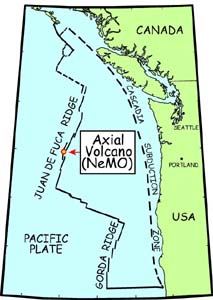 |
The Juan
de Fuca Ridge is a small portion of the world-wide mid-ocean ridge system
that happens to lie within 300 miles of the coast of the northwest U.S.
Here the seafloor spreads at about 6 cm per year. In the past 15 years,
three separate volcanic eruptions have been detected in the NE Pacific
by a formerly top-secret U. S. Navy system originally designed to detect
and track submarines. The most recent eruption occurred in 1998 on the
summit of a large seamount called Axial Volcano. Axial rises almost a
kilometer above the rest of the ridge, and is unusually shallow because
it has a high magma supply relative to the rest of the ridge. Axial is
the latest in a series of large volcanoes built by the passage of the
earth’s crust over a deeper "hot-spot" (the Cobb-Eikelberg
hotspot) in the mantle, which is the source of the extra magma supply.
In a sense, Axial is a hybrid feature, created where a hot-spot intersects
a mid-ocean ridge.
|







